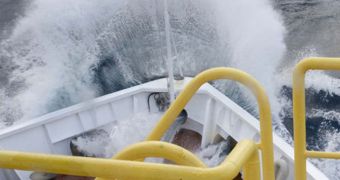Between January 4 and March 8 this year, an international team of experts conducted the Wilkes Land Glacial History Expedition in Antarctica, as part of the Integrated Ocean Drilling Program (IODP). During the study, the scientists collected ice core samples from the location, which they then transported back to the lab for analysis. Now, the data they obtained is being used to inform a new generation of computer models aimed at simulating future climate events based on our planet's past evolution.
One of the most mysterious events in Earth's climate history took place some 53 million years ago, about 10 million years after the Cretaceous-Paleogene (K-T) extinction event that saw the killing of dinosaurs. At that time, the Antarctic was a very lush, subtropical environment, which looked nothing like what it does today. This was largely caused by immense atmospheric carbon dioxide (CO2) levels, which exceeded those recorded today at least ten times over. When this period ended, the Antarctic suddenly transformed into the ice-covered wasteland it is today, over a very short geological time.
The reason why the new expedition was carried out in Wilkes Land was precisely because the area is extremely sensitive to climate change. In fact, it's the most sensitive area of Antarctica. By drilling here, experts hoped to collect the most relevant data of the transformations that led to Antarctica becoming covered in ice millions of years ago. Many experts hypothesized that, for some reason, CO2 concentrations dropped from their ultra-high levels to more “familiar” ones within less than 400,000 years, which is merely a second in geological time.
“The new cores offer an unprecedented ability to decipher the history of glaciation in Antarctica. The climate record they preserve is immensely valuable, especially for testing how well current global climate models reproduce past history,” explains the program director in the National Science Foundation (NSF) Division of Ocean Sciences (DOS), Jamie Allen. The DOS is one of the main co-funders of the IODP initiative. During the new Expedition, the international team collected more than 2,000 meters of sediment core from Wilkes Land.
“These sediments are essential to our research because they preserve the history of the Antarctic ice sheet. We can read these sediments like a history book. And this book goes back 53 million years, giving us an unprecedented record of how ice sheets form and interact with changes in the climate and the ocean,” concludes the leader of the expedition, expert Carlota Escutia. The scientist is based at the Research Council of Spain CSIC, and the University of Granada, and conducted the investigation with co-chief scientist Henk Brinkhuis of Utrecht University in The Netherlands.

 14 DAY TRIAL //
14 DAY TRIAL //